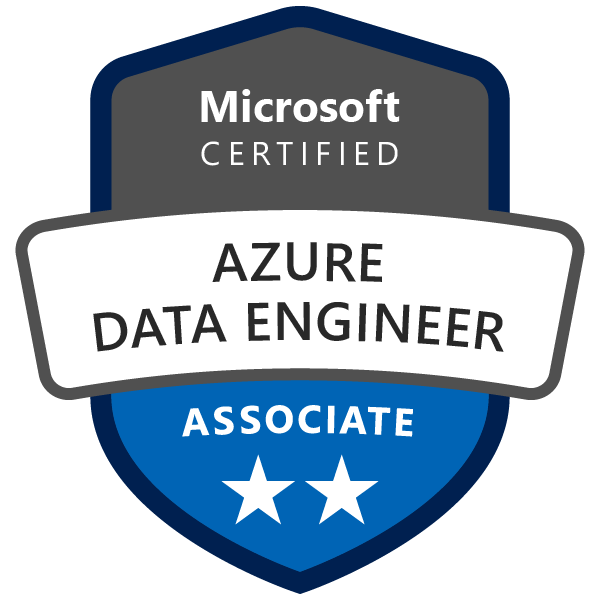In May 2021 I gained the Azure Data Engineer Associate certification by passing the single DP-203 exam required. I had previously gained this certification with 2 older exams so this was a chance to be tested on the current technology available on the Azure Data Platform.
In this short blog post I’d like to go through the current exam, its criteria, and learning resources. Whether you are new to data engineering in Azure or if you are already experienced in developing data solutions in Azure, it’s well worth working through the skills measured list to ensure you have the required knowledge.
Even if certification is not your main aim, working through the skills measured list is a great way to gain an understanding of the technology and the roles and responsibilities required to be an Azure Data Engineer.

Associate Overview
For the official certification overview page click here. This page discusses the roles and responsibilities of an Azure Data Engineer which includes “integrating, transforming, and consolidating data from various structured and unstructured data systems into structures that are suitable for building analytics solutions.”

Exam Details
There are currently 2 ways to gain the Associate certification, each is a valid method although the first option will retire on the 30th June 2021.
The DP-203 exam combines content from both the DP-200 and DP-201 exams and even though it’s a single exam, there is still a wide breadth of topics being assessed. If you have been studying for the DP-200 and DP-201 exams then you have a choice of continuing and taking these 2 exams, or take the single DP-203. The exam is around 70 questions with a pass mark of 700/1000.
The main categories being assessed are as follows:
- Design and implement data storage (40-45%)
- Design and develop data processing (25-30%)
- Design and implement data security (10-15%)
- Monitor and optimize data storage and data processing (10-15%)
You can download a detailed list of the required skills here which helps you identify areas in which you may need to learn.
Exam Experience
I chose to take the exam at home which meant I needed to be in a space that was clutter free. You are required to take photos of the area you are taking the exam in for verification by the exam proctor. You are also monitored via your webcam and must remain in view at all time. At one point I rested my chin on one hand and a message appeared telling me to move back into sight. It’s a smooth experience in my opinion and actually helps to calm any nerves.
I cannot go into detail about the content of the exam but I feel I can provide a general list of areas:
- Synapse Analytics Dedicated SQL Pools table distribution options and DMVs.
- Synapse Analytics Serverless SQL Pools connecting to and querying data in an Azure Storage/Data Lake Gen2 account.
- Data Factory Copy activity patterns.
- Basic Spark dataframe syntax.
- Stream Analytics queries to aggregate over time frames.
- Data Lake folder partitioning patterns.
- Basic dimensional modelling patterns such as Dimensions and Facts including Slowly Changing Dimensions.
The questions are a combination of multiple choice , drag-and-drop “put in sequence”, and true/false answers based on a data scenario. I find that if I can’t immediately answer the question, I start to eliminate options that don’t appear relevant to help guide me to the answer.
Learning Tips
Everyone is different when it comes to the best way of learning and retaining knowledge. If you can get hands-on in your current work role with each and every skill being measured then that will stand you in good stead. However, if you are unable to do so but have access to Azure then I find that creating a small example project whereby each skill is being used can help. For example, there are example Microsoft databases such as AdventureWorks and WideWorldImporters which you could use to work through all the measured skills.
Learning Materials
There are a variety of learning options available so whether you are starting out on your Azure Data Engineering journey (and good for you, it’s a fantastic journey) or are looking to plug a few gaps in your knowledge there are options available including:
Microsoft Learn
There are several Learning Paths available totalling roughly 37 hours. The Learn portal allows you to track progress when working through the material.
- Azure for the Data Engineer
- Store data in Azure
- Data integration at scale with Azure Data Factory or Azure Synapse Pipeline
- Realize Integrated Analytical Solutions with Azure Synapse Analytics
- Work with Data Warehouses using Azure Synapse Analytics
- Perform data engineering with Azure Synapse Apache Spark Pools
- Work with Hybrid Transactional and Analytical Processing Solutions using Azure Synapse Analytics
- Data engineering with Azure Databricks
- Large-Scale Data Processing with Azure Data Lake Storage Gen2
- Implement a Data Streaming Solution with Azure Streaming Analytics
Online Learning Platforms
There are several online learning platforms which cover the exam content.
- Pluralsight: Exam content currently includes the DP-200 and DP-201 exams but will also be relevant for DP-203.
- Whizlabs: Courses and practice exams covering the DP-200 and DP-201 exams but again this will be relevant for DP-203.
- Udemy: There are a variety of individual courses available on the Udemy platform.
Conclusion
Whether you are just starting out with a little experience or have being working with the Azure Data Platform and have gained considerable experience, it can be a positive experience working towards and gaining the Azure Data Engineer Associate certification. However you decide to work towards this certification, have fun and remember there’s a fantastic data community to help and encourage you along the way.
